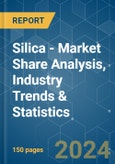The Silica Market size is estimated at 517.09 Million tons in 2024, and is expected to reach 704.48 Million tons by 2029, growing at a CAGR of 6.38% during the forecast period (2024-2029).
The primary consumer for silica is the construction industry; with the restart of a few construction activities after the COVID-19 pandemic, the demand for silica is coming back on track, Which is expected to balance the market for silica in the construction industry. Increasing high-quality concrete usage is also expected to drive the market in the upcoming years. The use of silica in electronics is another major factor that is likely to drive the market.
This product will be delivered within 2 business days.
The primary consumer for silica is the construction industry; with the restart of a few construction activities after the COVID-19 pandemic, the demand for silica is coming back on track, Which is expected to balance the market for silica in the construction industry. Increasing high-quality concrete usage is also expected to drive the market in the upcoming years. The use of silica in electronics is another major factor that is likely to drive the market.
Key Highlights
- The increasing demand for precipitated silica for different end users and rapidly expanding construction activities are likely to drive the growth of the silica market.
- On the flip side, competition from substitute products is expected to hinder the market growth.
- The growing emergence of green tires and the increasing adoption of electric and self-driving cars are expected to unveil new opportunities for the market studied.
- Asia-Pacific is expected to dominate the silica market due to the high demand from China, Japan, and India.
Silica Market Trends
Increasing Demand from the Building and Construction Industry
- Silica is one of the primary components in various building and construction products. For improved durability and structural integrity, whole-grain silica is used in flooring, mortars, specialty cement, roofing shingles, asphalt mixtures, skid-resistant surfaces, and other industrial materials.
- The Asia-Pacific region is dominating construction activities across the world. The area is registering a fast recovery after the COVID-19 impact, due to increasing construction in China, India, Japan, and Indonesia, among others. China is investing USD 1.43 trillion in significant construction projects in the next five years till 2025.
- According to the US Census Bureau and the US Department of Housing and Urban Development, privately-owned residential units permitted by building permits totaled 1,873,000 in December 2021, a seasonally adjusted annual rate of 1,873,000.
- Building output increased by 3.3% in the eurozone and 3.8% in the EU in July 2021 compared to July 2020. In November 2021, construction output increased by 0.5% in the euro and 1.3% in the EU compared to November 2020.
- The Egyptian government plans to relocate to a vast "New Administrative Capital" 30 miles east of Cairo by the end of 2022. The new capital is being built to relieve Cairo's overcrowding, reduce traffic congestion, and provide the country with modern infrastructure. The USD 45 billion projects will include a new airport, government offices, residential areas, business districts, and green spaces.
- All the above factors will likely propel the demand for silica sand during the forecast years.
Asia-Pacific Region Expected to Dominate the Market
- The Asia-Pacific region is expected to be the dominant market in silica consumption, as China and India dominate the market for the end-user industries, such as building and construction, electronics, and glass manufacturing.
- China's building industry is expanding at a rapid pace. China's construction production is estimated to be worth CNY 29.31 trillion in 2021, according to the National Bureau of Statistics of China.
- China plans to invest USD 1.43 trillion in key construction projects for five years till 2025. The Shanghai plan, according to the National Development and Reform Commission (NDRC), calls for a total investment of USD 38.7 billion over the next three years. Guangzhou, on the other hand, signed 16 new infrastructure projects for USD 8.09 billion.
- Over the next seven years, India is expected to invest over USD 1.3 trillion in housing, with 60 million new homes being built. In 2024, the rate of affordable housing availability is predicted to increase by roughly 70%.
- The Japanese construction industry is predicted to boom as the country prepares to host the World Expo in Osaka, Japan, in 2025. The Yaesu redevelopment project, which includes a 61-story, 390-meter tall office tower, is scheduled to be completed in 2023 and 2027, respectively.
- Due to all the above-mentioned factors, the Asia-Pacific region is expected to dominate the market during the forecast period.
Silica Industry Overview
The silica market is fragmented, with both international and domestic players. The major companies (not in any particular) in the market studied include Covia Holdings LLC, US Silica, Sibelco, Cabot Corporation, and Evonik Industries AG.Additional Benefits:
- The market estimate (ME) sheet in Excel format
- 3 months of analyst support
This product will be delivered within 2 business days.
Table of Contents
1 INTRODUCTION
4 MARKET DYNAMICS
5 MARKET SEGMENTATION
6 COMPETITIVE LANDSCAPE
7 MARKET OPPORTUNITIES AND FUTURE TRENDS
Companies Mentioned (Partial List)
A selection of companies mentioned in this report includes, but is not limited to:
- AGSCO Corp.
- AMS Applied Material Solutions
- Cabot Corporation
- China-Henan Huamei Chemical Co. Ltd
- Covia Holdings Corporation
- Denka Company Limited
- Evonik Industries AG
- Heraeus Holding
- Kemitura Group AS
- Merck KGaA
- Madhu Silica Pvt. Ltd
- Mitsubishi Chemical Corporation
- Nouryon
- OCI COMPANY Ltd
- PPG Industries Inc.
- Sibelco
- Tokuyama Corporation
- US Silica
- Wacker Chemie AG
- WR Grace & Co.-Conn.
Methodology

LOADING...










